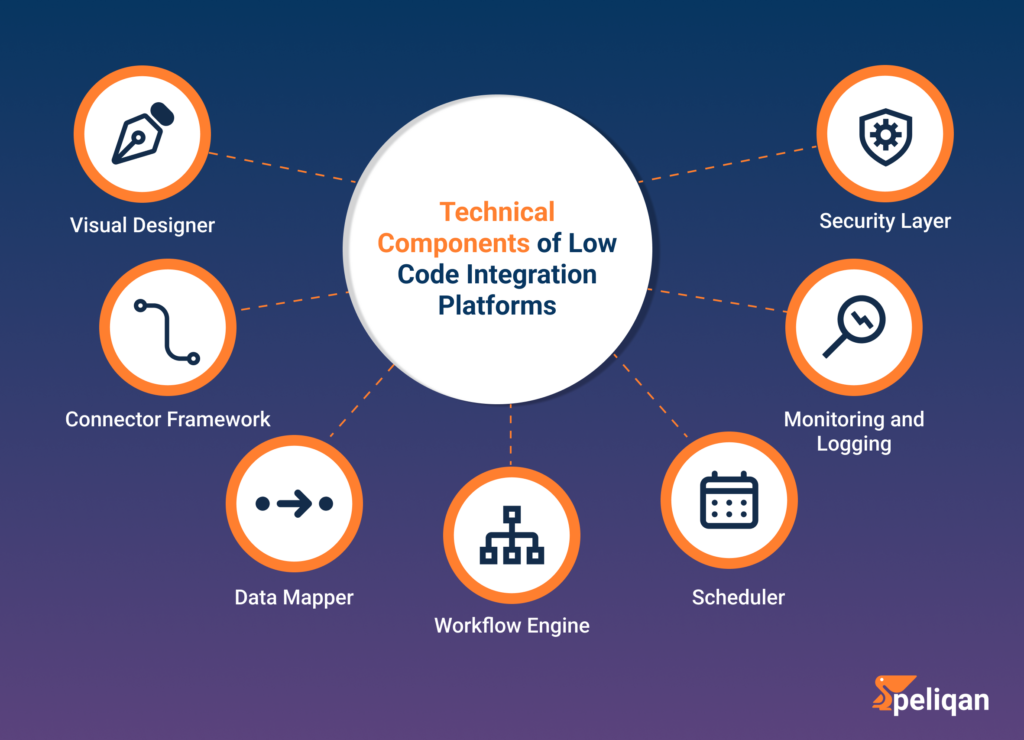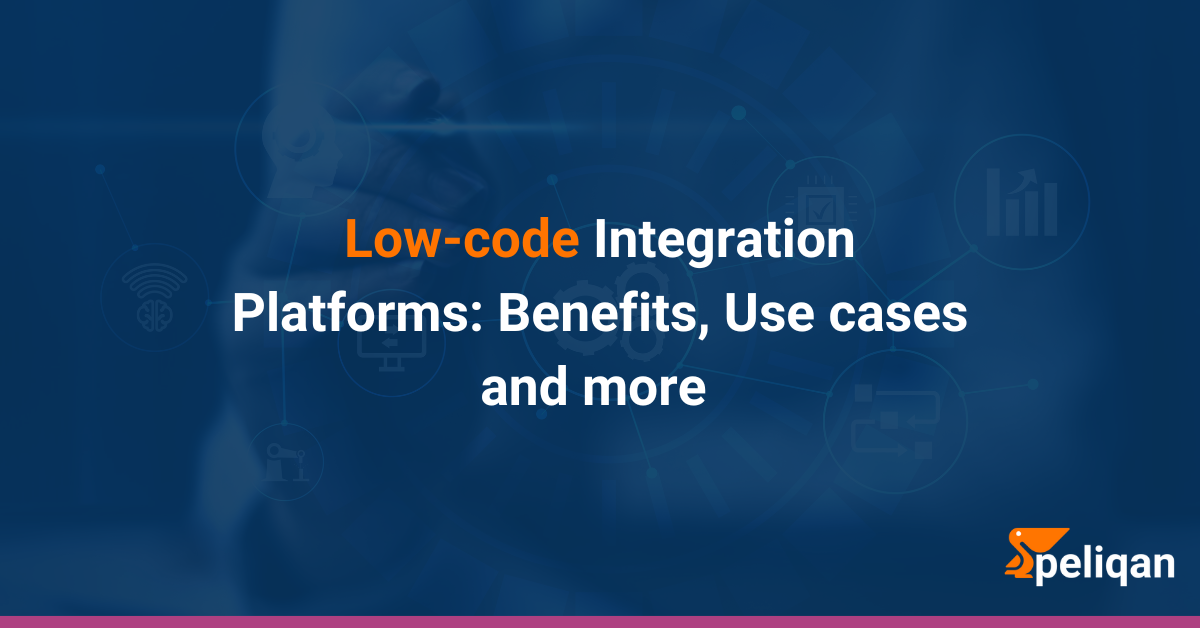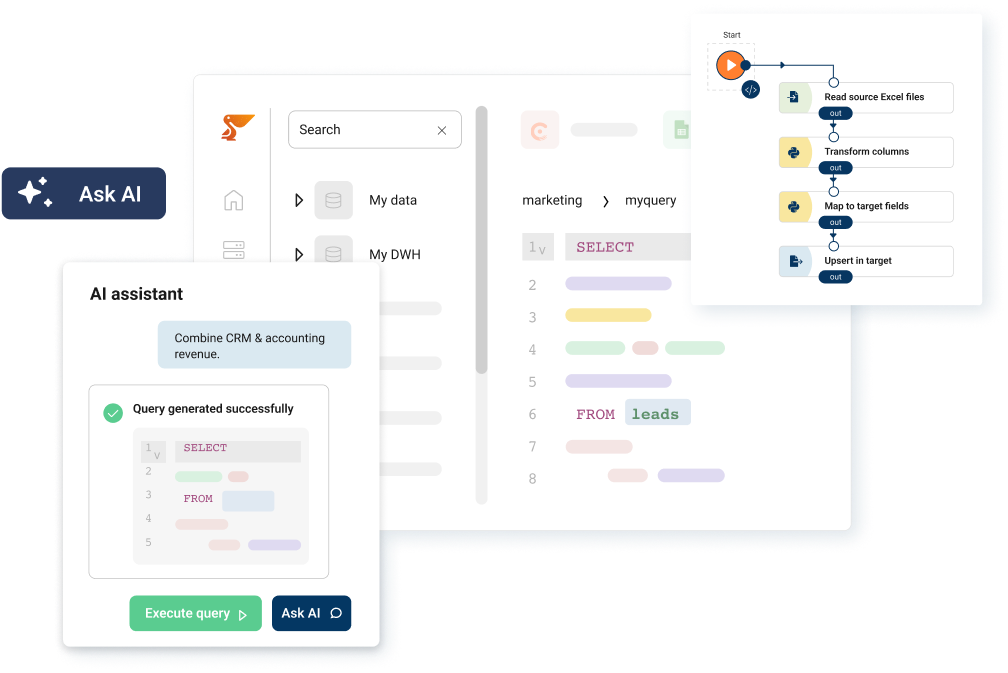In today’s fast-paced digital landscape, businesses are constantly seeking ways to streamline their operations, improve efficiency, and stay competitive. One of the most promising solutions to emerge in recent years is the use of low code integration platforms. These powerful tools are revolutionizing how organizations connect their various software applications, automate workflows, and manage data.
In this comprehensive guide, we’ll explore the world of low code integration platforms, with a special focus on Peliqan, the leading solution in this space.
What are Low Code Integration Platforms?
Low code integration platforms are innovative software solutions that enable businesses to connect various applications, synchronize data, and automate workflows with minimal hand-coding. These platforms provide a visual interface and pre-built connectors, allowing both technical and non-technical users to create powerful integrations between different software systems.
Now that we understand what low code integration platforms are, let’s explore what makes them unique in the world of software integration.
Low Code Integration Platforms: Why it is unique
Low code integration platforms stand out from traditional integration methods by offering a more accessible and efficient approach to connecting systems and automating processes. Unlike traditional integration methods that require extensive coding knowledge and time-consuming development, low code integration platforms offer a more accessible and efficient approach. They typically feature:
- Pre-built connectors for popular applications
- Visual workflow designers
- Built-in data mapping tools
- Automated error handling and monitoring
To fully appreciate the power of low code integration platforms, it’s important to understand their key features and capabilities.
Key Features of Low Code Integration Platforms
- Visual Workflow Designers: These intuitive interfaces allow users to create complex integration workflows by simply dragging and dropping elements onto a canvas. Users can visually map out the flow of data and processes, making it easy to understand and modify integrations without diving into code.
- Pre-built Connectors: Low code platforms come with an extensive library of pre-configured connectors for popular applications and services. These connectors handle the complexities of API communication, authentication, and data formatting, allowing users to quickly integrate systems like Salesforce, SAP, Oracle, and hundreds of other business applications.
- Drag-and-Drop Interfaces: The user-friendly drag-and-drop functionality enables both technical and non-technical users to build integrations. This feature allows for rapid prototyping and development, significantly reducing the time and expertise required to create complex integrations.
- Built-in Data Mapping Tools: These tools provide a visual interface for transforming and mapping data between different systems. Users can easily define how fields from one system correspond to fields in another, apply transformations, and handle data type conversions without writing complex code.
- Scalable Architecture: These platforms are designed to grow with your business. They can handle increasing data volumes, transaction loads, and integration complexity without requiring significant redevelopment. This scalability ensures that your integration solution remains effective as your business expands.
- AI Platform Integration: Low-code platforms now come with built-in support for AI Platform Integration, allowing teams to plug into AI models, automate classification or prediction tasks, and enrich workflows with intelligent insights – without writing complex code.
This approach democratizes the integration process, allowing a wider range of team members to participate in creating and managing integrations.
Low-code Integration vs Traditional Integration
Low-code integration platforms typically support a wide range of integration types, including:
- Application-to-Application (A2A): Connecting different software applications (e.g., CRM, ERP, HR).
- Data Integration: Transferring data between systems and databases.
- API Integration: Connecting to cloud-based services and APIs.
- File Transfer: Moving files between systems and storage locations.
- Enterprise Application Integration (EAI): Connecting disparate systems within an enterprise.
|
Feature |
Low-Code Integration |
Traditional Integration |
|---|---|---|
| Development Speed | Rapid | Slow |
| Technical Expertise | Minimal | High |
| Cost | Lower | Higher |
| Flexibility | High | Lower |
| Scalability | High | Lower |
With these differences in mind, let’s examine why low code integration platforms are gaining popularity in today’s business landscape.
Low Code Integration Platform Benefits
Low code integration platforms offer a multitude of advantages that are reshaping how businesses approach system integration and process automation. These platforms provide a unique combination of accessibility, efficiency, and flexibility that traditional integration methods often lack.
By empowering a wider range of users to create and manage integrations, these platforms are driving innovation, reducing costs, and enabling organizations to respond more quickly to changing market conditions. Low code integration platforms offer numerous advantages for businesses of all sizes:
- Increased Efficiency: By automating data flows and processes between applications, low code integration platforms significantly reduce manual data entry and the associated errors. This leads to streamlined operations and improved overall efficiency.
- Cost Savings: Low code platforms reduce the need for specialized developers, cutting down on integration costs. They also minimize the time required to develop and deploy integrations, resulting in faster time-to-value.
- Improved Data Accuracy: Automated data synchronization ensures that information is consistent across all integrated systems, reducing errors and improving decision-making based on accurate, up-to-date data.
- Scalability: As businesses grow, low code integration platforms can easily scale to accommodate new applications and increased data volumes without requiring significant redevelopment.
To better understand how low code integration platforms deliver these benefits, let’s examine their key technical components.
Technical Components of Low Code Integration Platforms
At the heart of low code integration platforms lies a sophisticated set of technical components that work together to simplify the data integration process. These components form the backbone of the platform, enabling users to create powerful integrations with minimal coding.
From visual designers to data mappers, each component plays a crucial role in transforming complex integration tasks into manageable, intuitive processes that can be handled by both technical and non-technical users alike. To better understand how low code integration platforms work, let’s examine their key technical components:

- Visual Designer: The graphical interface where users create integration workflows. It typically uses drag-and-drop functionality and pre-built connectors.
- Connector Framework: A system for creating and managing pre-built connectors to various applications and services. This often includes an SDK for developing custom connectors.
- Data Mapper: A tool for transforming data between different formats and structures. It often includes functions for data manipulation, such as string operations, mathematical calculations, and date/time conversions.
- Workflow Engine: The core component that executes the integration logic, managing the flow of data and operations between connected systems.
- Scheduler: A module for triggering integrations based on time or events, allowing for both real-time and batch processing.
- Monitoring and Logging: Systems for tracking the performance and status of integrations, often including alerting capabilities for error handling.
- Security Layer: Components handling authentication, authorization, and data encryption across the integration platform.
How Low Code Integration Platforms Work
Low code integration platforms operate on a principle of simplification, taking complex integration tasks and breaking them down into manageable, visual processes. These platforms leverage a combination of pre-built connectors, intuitive interfaces, and automated tools to streamline the integration workflow.
By abstracting away much of the technical complexity, low code platforms enable users to focus on the business logic of their integrations, rather than getting bogged down in code-level details. Many modern platforms even allow users to create visuals with AI to represent workflows and data flows more effectively, enhancing clarity and collaboration between technical and non-technical teams.
To fully appreciate the value of low code integration platforms, it’s essential to understand their underlying mechanisms:
Connectors:
Pre-built modules that facilitate communication with specific applications or data sources. These connectors handle the complexities of APIs, authentication, and data formats for popular business applications. For example, a Salesforce connector would manage the authentication process, API calls, and data mapping required to integrate Salesforce with other systems.
Visual Workflow Designer:
A graphical interface for designing integration workflows using drag-and-drop elements. Users can visually map out the flow of data and processes between different systems. This might include steps like retrieving data from a source system, applying transformations, and then sending the data to a target system. The visual nature makes it easy to understand and modify complex integrations.
Data Mapping:
Visual tools for specifying how data should be transformed and matched across applications. Users can define rules for how fields in one system correspond to fields in another, apply transformations (like date format changes), and handle data type conversions. This ensures that data is correctly formatted and aligned as it moves between systems.
Business Logic and Rules:
Define conditional statements, loops, and custom functions to handle complex scenarios. This might include routing data based on certain conditions, aggregating information from multiple sources, or applying complex calculations. For example, an order processing workflow might include logic to route high-value orders to a special handling process.
Testing and Deployment:
Built-in capabilities to validate integrations before deployment to production environments. Users can run test scenarios, debug issues, and ensure that the integration performs as expected before going live. This reduces the risk of errors and ensures smooth operation in production.
Monitoring and Management:
Tools to track integration performance, identify issues, and manage changes over time. This includes dashboards showing the status of active integrations, alerts for any errors or anomalies, and version control features to manage changes to integration workflows. These tools help ensure the ongoing health and efficiency of the integration ecosystem.
Now that we’ve explored the technical aspects, let’s look at some real-world applications of low code integration platforms across various industries and business functions.
Use Cases of Low Code Integration Platforms
Low code integration platforms have found applications across a wide range of industries and business functions, demonstrating their versatility and power. From streamlining customer data management to automating complex supply chain processes, these platforms are helping organizations tackle diverse challenges.
The ability to quickly create and modify integrations allows businesses to respond rapidly to changing market conditions, improve operational efficiency, and deliver enhanced experiences to both customers and employees. Low code integration platforms can be applied to a wide range of business scenarios. Here are some common use cases:
Customer Data Synchronization
Integrate CRM systems with marketing automation tools and social media channels. This ensures a consistent view of customer data across all touchpoints, enabling personalized marketing campaigns and improved customer service. For example, when a customer updates their contact information in a web form, the data can be automatically updated in the CRM, affordable email marketing platform, and support ticketing system.
E-commerce Order Processing
Streamline order fulfillment by connecting online stores with inventory and shipping systems. This automation can reduce processing times, minimize errors, and improve customer satisfaction. When an order is placed on an e-commerce platform, it can trigger updates to inventory levels, generate shipping labels, and send confirmation emails to customers, all without manual intervention.
HR Process Automation
Automate onboarding, offboarding, and benefits administration processes. This can significantly reduce paperwork and ensure consistent processes across the organization. For instance, when a new employee is hired, a workflow could automatically create their email account, add them to relevant systems, schedule orientation sessions, and trigger the necessary paperwork for benefits enrollment.
Financial Data Consolidation
Consolidate financial data from multiple sources for accurate reporting and forecasting. This can involve pulling data from various departmental systems, bank accounts, and financial tools into a central repository for analysis. The integration can automate the generation of financial reports, reconcile accounts, and provide real-time visibility into the organization’s financial health.
IoT Data Integration
Collect and process data from IoT devices for predictive maintenance and real-time monitoring. For example, in a manufacturing setting, data from sensors on production equipment can be integrated with maintenance scheduling systems to predict when maintenance is needed, reducing downtime and optimizing resource allocation.
Supply Chain Management
Improve visibility and collaboration across the supply chain ecosystem. Integrations can connect systems for inventory management, logistics, supplier portals, and customer order management. This provides real-time visibility into stock levels, order status, and supplier performance, enabling more efficient supply chain operations and better decision-making.
With a clear understanding of the capabilities and use cases of low code integration platforms, let’s consider the factors to keep in mind when selecting the right platform for your organization.
Top 10 Low-code Integration Platforms
Choosing the Right Low Code Integration Platform
Selecting the ideal low code integration platform for your organization is a critical decision that can significantly impact your digital transformation efforts. The right platform should align with your specific business needs, technical requirements, and long-term strategic goals.
Factors such as ease of use, scalability, security features, and integration capabilities all play crucial roles in determining the best fit for your organization. A thoughtful evaluation process can ensure you select a platform that not only meets your current needs but can also grow with your business. Selecting the appropriate low code integration platform for your business is crucial. Consider the following factors:
1. Ease of Use
A platform with a user-friendly interface accelerates development and reduces training time. Look for platforms that has pre-built templates, and clear documentation. Consider if the platform supports a visual workflow designer, making it accessible to both technical and non-technical users.
2. Connector Availability
A wide range of pre-built connectors saves time and effort. Ensure the platform offers connectors for your critical applications and systems, such as CRM, ERP, marketing automation, and cloud storage. Additionally, check if the platform supports custom connectors for unique integrations.
3. Scalability
Your integration needs might grow over time. Choose a platform that can handle increasing data volumes, transaction loads, and integration complexity. Consider the platform’s ability to scale horizontally and vertically to accommodate future growth.
4. Security and Compliance
Data security is paramount. Verify that the platform adheres to industry standards like GDPR, NIS2. Look for features like data encryption, access controls, and audit trails. Consider the platform’s ability to meet specific compliance requirements for your industry.
5. Support and Documentation
Robust support and comprehensive documentation are essential for successful implementation. Evaluate the platform’s customer support channels (email, phone, chat), response time, and knowledge base resources. Consider if the platform offers training and certification programs.
6. Pricing Model
Different platforms offer various pricing models (subscription, usage-based, perpetual license). Evaluate the total cost of ownership, including implementation, maintenance, and support costs. Consider if the pricing aligns with your budget and expected usage.
7. Customization Options
While low-code platforms aim to reduce coding, some customization might be necessary. Assess the platform’s ability to integrate custom code or scripts for specific requirements. Consider if the platform supports custom connectors or API development.
Having discussed the key factors to consider, let’s examine Peliqan, a standout solution in the low code integration platform landscape.
Best Low Code Integration Platform
In the crowded landscape of low code integration platforms, Peliqan stands out as a comprehensive solution designed to meet the diverse needs of modern businesses. Peliqan is an all-in-one data platform designed for business teams, startups, scale-ups, and IT service companies.
Why Peliqan can be of best choice?
With its focus on simplifying data management and integration, Peliqan is empowering organizations to harness the full potential of their data without the need for extensive technical expertise. Here’s a summary of what Peliqan offers:
Comprehensive Data Integration:
- Connects to over 100 SaaS applications, databases, and file sources
- Provides ETL (Extract, Transform, Load) capabilities with a built-in data warehouse
- Offers options to use external data warehouses like Snowflake, BigQuery, Redshift, or SQL Server
Data Transformation and Analysis:
- Allows data transformation using SQL, low-code Python, and a spreadsheet-like interface
- Supports ad-hoc analysis and data preparation for downstream usage
- Includes an AI assistant to help write SQL queries based on natural language questions
Data Activation and Automation:
- Enables reverse ETL to sync data between business applications
- Supports creating and publishing API endpoints
- Allows setting up alerts and distributing custom personalized reports
Low-Code Development:
- Combines SQL with low-code Python for implementing various data use cases
- Supports building data apps, APIs, and syncs quickly
Business Intelligence and Visualization:
- Integrates with popular BI tools
- Offers one-click deployment of tools like Metabase, Jupyter notebooks, and Apache Superset
Data Governance and Management:
- Provides automatic data lineage detection and a data catalog for metadata storage
- Ensures data security and compliance
Scalability and Flexibility:
- Suitable for various business sizes and types, from startups to enterprise-level organizations
- Offers white-label solutions for integrators, software companies, and agencies
In essence, Peliqan is a user-friendly low-code data platform that bridges the gap between data sources, analysis, and activation, enabling businesses to leverage their data effectively without extensive technical expertise.
Conclusion
The rise of low code integration platforms marks a significant shift in how businesses approach system integration and process automation. Low-code integration platforms are reshaping the business landscape by streamlining operations and enhancing efficiency. These innovative tools enable organizations to seamlessly connect disparate systems, automate complex processes, and extract valuable insights from their data.
By offering user-friendly interfaces and pre-built components, low-code platforms democratize application development, allowing both IT and business teams to collaborate effectively. This collaborative approach accelerates development cycles, reduces costs, and improves overall business agility.
Peliqan is a powerful low-code integration platform that empowers organizations to achieve their digital transformation goals. By leveraging Peliqan’s capabilities, businesses can optimize operations, improve data management, and gain a competitive advantage.
As the digital landscape continues to evolve, low-code integration platforms will play an increasingly critical role in driving business success. By adopting these solutions, organizations can adapt to changing market conditions, enhance customer experiences, and achieve long-term growth.





